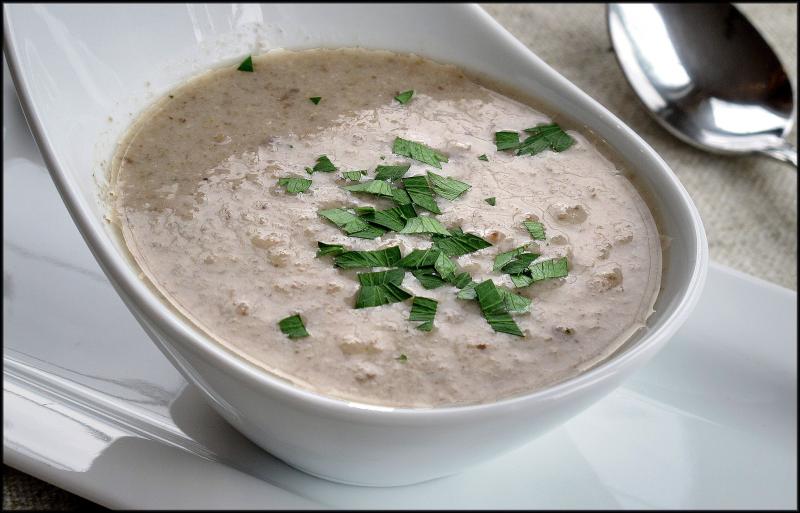Simmering soups drive away autumn chills
Temperatures have fallen just enough to spark my interest in making soup. Note, the key term here is “making,” not the phrase “opening a can and heating up.” If you’re like me, you may have noticed the ingredient list on canned and packaged soups includes a few things you might not want or need in your bowl.
For example, when I make tomato soup, there are only a few ingredients: tomatoes, onions, vegetable broth, butter and herbs. If I were to reach for a familiar can with the red and white label, the ingredient list is longer, to include high-fructose corn syrup, wheat flour and monopotassium phosphate. The last of these is actually a water-soluble plant fertilizer, so I’m not exactly sure of its purpose.
There are also a few misconceptions about how difficult or time-consuming it is to make soup. The longest step is the time it takes to simmer broth from bones, meat, fish or vegetables. To save time, it’s fine to reach for a container of packaged broth, as long as you check the ingredients and avoid excessive sodium.
Maybe we should back up a bit and define what we mean by soup. Most of us know it’s a liquid food, generally (but not always) served warm. The key flavors of different types of soup are created by the specific ingredients (fish, beef, chicken, vegetables, etc.) and the liquids (water, broth or stock) in which they’re simmered.
Although soup and stew may be made from comparable ingredients, stew is expected to be thicker and richer than soup; soup has a higher ratio of liquid to solids. If you turn to the definitions in French cuisine, the distinctions are more precise, with a divide between clear soups (bouillon and consommé) and thickened soups.
Thick soups are characterized based on how they’re thickened. Pureés use vegetable starch as a thickening agent. This can be either dissolving vegetable pieces as they cook, or an actual process of pureéing the mixture to a smooth consistency. Bisques are thickened with cream, while elegant veloutés are thickened with a mixture of egg, butter and cream.
As you may imagine, the idea of simmering a bunch of ingredients in a big pot was an easy way to feed the family and has been a familiar technique for centuries. With different climates, key ingredients and cooking techniques, many regions have developed a signature soup. Consider Boston bean, Maryland crab, Scotch broth, Hungarian goulash and Creole gumbo, just to name a few examples.
The mushroom soup in the photo was inspired by a tray of sliced mushrooms no longer pretty enough to toss in a spinach salad. All it took was chopped onions and the mushrooms, sautéed in butter until fragrant and soft. I poured in vegetable broth and let things boil for about 10 minutes, tossing in some thyme.
When I was ready to serve the soup, I used an immersion blender to puree the mixture. As a word of caution, do not attempt to use an immersion blender in a soup pot while it is still on a live burner – things can get very hot and quite messy. Ladle your soup into bowls and top with some snipped parsley.
This technique (onion, vegetable, broth and herbs) is the basis for almost every soup I make. For tomato soup, I use a can of tomato purée or leftover tomatoes, sometimes added straight from the freezer. Season with basil or tarragon and sprinkle with Parmesan cheese. Butternut squash, carrots, leeks, potatoes – all of these can become hearty soup in a similar way.
I’ve included a recipe for what I would call “basic” soup. In each case, you can use beef, chicken or vegetable broth depending upon how deep a flavor background you want to add. For delicate leeks, stick with chicken or vegetable; for heartier mushroom or tomato, beef broth adds richness.
For each vegetable there is a set of herbs that go well, as shown in the list below, but don’t hesitate to experiment with your favorite combinations. I’ve also noted that a squeeze of lemon is an optional addition; this works especially well with butternut squash and carrot, which can be a bit dull. Let’s make some soup!
Basic Soup
1 T butter or olive oil
1 chopped onion
2 C chopped vegetables*
2 C broth or stock
herbs, salt & pepper, to taste
1 t lemon juice (optional)
Heat the butter or olive oil in a large saucepan. Add onion and sauté until translucent, about 3 minutes. Add chopped vegetables and cook until slightly softened, about 5 minutes. Pour in broth or stock and bring to a boil. Reduce heat and cover; simmer until vegetables are cooked through, about 10 minutes. With a food processor or immersion blender, purée the soup until smooth. Stir in herbs; finish with salt and pepper, to taste. If desired, add a squeeze of fresh lemon juice to brighten the flavor. *Note: peel, pare and trim the vegetables as needed. See chart below for herb suggestions.
Vegetable & Herb Combinations
Broccoli - oregano or marjoram
Butternut Squash - cardamom or cinnamon
Carrot - cumin or curry
Leek - nutmeg or dill
Mushroom - thyme or paprika
Potato - chive or parsley
Tomato - basil or tarragon




















































